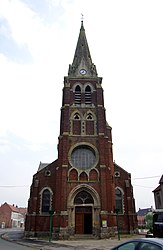Busnes (French pronunciation: [byn]; West Flemish: Bune) is a commune in the Pas-de-Calais department in the Hauts-de-France region in northern France.[3]
Busnes
Bune | |
|---|---|
 The church of Busnes | |
| Coordinates: 50°35′19″N 2°31′09″E / 50.5886°N 2.5192°E | |
| Country | France |
| Region | Hauts-de-France |
| Department | Pas-de-Calais |
| Arrondissement | Béthune |
| Canton | Lillers |
| Intercommunality | CA Béthune-Bruay, Artois-Lys Romane |
| Government | |
| • Mayor (2020–2026) | Franck Hannebicq[1] |
Area 1 | 9.55 km2 (3.69 sq mi) |
| Population (2021)[2] | 1,245 |
| • Density | 130/km2 (340/sq mi) |
| Time zone | UTC+01:00 (CET) |
| • Summer (DST) | UTC+02:00 (CEST) |
| INSEE/Postal code | 62190 /62350 |
| Elevation | 17–20 m (56–66 ft) (avg. 19 m or 62 ft) |
| 1 French Land Register data, which excludes lakes, ponds, glaciers > 1 km2 (0.386 sq mi or 247 acres) and river estuaries. | |
Geography
editA farming village some 8 miles (13 km) northwest of Béthune and 23 miles (37 km) west of Lille, at the junction of the D916, D94 and the D187 roads.
History
editIn 1346, in retaliation for having besieged the town of Bethune, Flemish bands, commissioned by Oudart of Renty, sacked many of the neighbouring villages and particularly Busnes. The inhabitants took refuge in the church in order to protect themselves. The church was strengthened to make it more resilient to attacks.
In 1383, English troops pillaged and plundered the village, on their rampages during the Hundred Years War.
In 1519, the church was badly damaged and had to be rebuilt.
From 1537 to 1543, during the time of wars of religion and again in 1655, the Spanish and French came in their turn, causing fires and terrible destruction.
During revolutionary turmoil in 1793, demagogues from Saint-Venant decided to come to Busnes to burn the statues of the Saints in the church. The patriots of Busnes resisted valiantly and thus prevented further destruction.
During the French Revolution, the church was sold and became a public building, which, in turn, served as a club, dance hall and gunpowder factory.
It was not until February 20, 1802 that it again became a place of worship.
The church, which over the centuries had been badly burned and repaired, was finally demolished in 1870. Construction of the new church started in the following years.
The village was awarded the Croix de Guerre after World War I.
Population
edit| Year | Pop. | ±% p.a. |
|---|---|---|
| 1968 | 1,106 | — |
| 1975 | 1,178 | +0.91% |
| 1982 | 1,266 | +1.03% |
| 1990 | 1,337 | +0.68% |
| 1999 | 1,294 | −0.36% |
| 2009 | 1,255 | −0.31% |
| 2014 | 1,278 | +0.36% |
| 2020 | 1,244 | −0.45% |
| Source: INSEE[4] | ||
Sights
edit- The church of St. Paul, dating from the nineteenth century.
- The chateau of Beaulieu.
- The chateau of Quesnoy, dating from the seventeenth century.
- The Commonwealth War Graves Commission cemetery.
- The war memorial.
Famous residents
edit- Busnes may be the origin of the surname of the composer Antoine Busnois, who is known to have come from the area.
See also
editReferences
edit- ^ "Répertoire national des élus: les maires". data.gouv.fr, Plateforme ouverte des données publiques françaises (in French). 9 August 2021.
- ^ "Populations légales 2021" (in French). The National Institute of Statistics and Economic Studies. 28 December 2023.
- ^ INSEE commune file
- ^ Population en historique depuis 1968, INSEE
External links
edit



